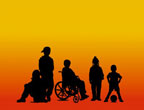The
physical, mental and social benefits derived from sports
participation for all ages and abilities are widely accepted.
Research examining the influence of physical activity, exercise and
sports participation on individuals with and without disabilities
shows sports:
• Increase muscle strength and flexibility.
• Improve exercise endurance and cardiovascular efficiency.
• Enhance balance, motor development and motor skills.
• Support self-concept and body awareness.
• Help develop sportsmanship.
• Promote a positive environment for friendship.
Sports participation promotes social interaction, peer acceptance
and development of social skills and self-esteem in both able-bodied
and disabled children. Participation also can teach able-bodied
children to be sensitive to those who are different.
 In spite of these benefits, children with physical disabilities are
less likely to engage in these activities than their able-bodied
peers. Disabled children often have limited access to recreational
activities, sports participation, knowledgeable coaches or adapted
fitness leaders, and competent, active role models with similar
disabilities capable of providing both instructional and
motivational feedback.
In spite of these benefits, children with physical disabilities are
less likely to engage in these activities than their able-bodied
peers. Disabled children often have limited access to recreational
activities, sports participation, knowledgeable coaches or adapted
fitness leaders, and competent, active role models with similar
disabilities capable of providing both instructional and
motivational feedback.
In 2002, the Centers for Disease and Control Prevention, the Surgeon
General and the President's Council on Physical Fitness identified
concerns related to the lack of physical activity in the daily lives
of Americans with physical disabilities and the negative impact this
has on their primary and secondary medical conditions. Research
shows that children with disabilities are at an increased risk for
developing:
• Obesity.
• Poor cardiopulmonary endurance.
• Muscle atrophy.
• Joint contractures.
Rates of obesity are especially high in children with Down syndrome,
muscular dystrophy, spina bifida and spinal cord injury, making
adaptive sports and recreation of significant importance. However,
participation by these children in sporting activities may bring
about unique issues and injuries. Pediatric physical medicine and
rehabilitation and pediatric orthopedics are specialties that can
assist in screening, prevention and treatment to ensure safety with
participation to gain maximum effects.
Adapted sports programs are being organized in many communities,
either in an integrated (athlete participates with others who have
no disabilities) or segregated (athlete participates only with other
athletes with disabilities) environment. These programs give
children with disabilities increased opportunity to achieve the main
goal of adapted sports – independent participation. There are two
major adaptive sports movements:
• Paralympics – for people with physical disabilities.
• Special Olympics – for people with intellectual disabilities.
Both of these movements have grown dramatically since their
initiation, reflecting an increased awareness of the abilities of
people with disabilities. There have been increases in competitive
opportunities for disabled children to participate at recreational,
local and regional events. Legislation also has helped stimulate the
development of adaptive sports in the U.S. Yet, with increased
participation and competition come unique issues and injuries
pertaining to the physically challenged child.
Children in general have different bone structure, open growth
plates and decreased ability to withstand heat stresses compared to
adults. Physicians need to be mindful of these differences. The
American Academy of Pediatrics recommends that every athlete without
a disability have a preparticipation examination at least once a
year, but little has been published about guidelines for athletes
with disabilities. Although it is recommended to use the standard
PPE, it is important to take into account the particular
co-morbidities associated with a disabled child's primary
impairment. The PPE goals for disabled children are the same as for
the typically developing child, including:
• Identifying musculoskeletal conditions that could make sports
participation unsafe.
• Screening for underlying illnesses.
• Recognizing pre-existing injury patterns.
• Devising rehabilitation programs to prevent recurrences.
PPEs for disabled children should include all the components of the
standard PPE. The physical exam also should include all organ
systems, with special focus on those affected by the child's
disability. It should evaluate general cognition, memory and
judgment. The physical exam should consider not only the disability;
it also should be sports specific. Following are examples of what to
look for during a physical exam.
Subjective/history
• Athletic goal of the individual.
• Current level of training and sports participation.
• Impairment and level of functional independence for mobility and
self-care.
• Orthosis, assistive devices, adaptive equipment or prosthesis.
• Emotional, psychiatric or behavioral problems. (This is extremely
important as children should not be cleared for sports that could be
hazardous to themselves or others. Examples include weight lifting
and archery.)
• Past history, including sports-associated lesions. (Injury
incidence and patterns are similar for athletes with and without
disabilities. However, location of injury appears to be disability
and sports dependent. For example, wheelchair sports participants
have more upper extremity injuries while ambulatory children tend to
have more lower extremity injuries.)
• Medications. (For example, anticholinergics may cause
thermoregulation problems and muscle relaxants may cause sedation.)
• Review of systems. (Consider presence of external devices for
bladder drainage or for bowel evacuation, wound dressings and
pressure sores, etc.).
Objective
Always evaluate affected and unaffected extremities, with and
without prosthesis, braces or other devices. Evaluate the patient's
mobility with a wheelchair or any assistive devices that will be
used for sports participation, checking equipment for fit and wear.
In addition:
• Assess for skin integrity, especially in patients with spina
bifida, spinal cord injury or amputations and those who participate
in wheelchair sports.
• Watch for upper extremity overuse in wheelchair users and lower
extremity overuse in cerebral palsy patients who ambulate.
• Review joint stability and range of motion, flexibility. (Down
syndrome patients may have knee and hip problems due to hypotonia
and generalized ligamentous laxity; cerebral palsy patients may
experience issues with tightness and strains.)
• Measure muscle strength.
• Evaluate muscle tone, deep tendon reflexes and Babinski reflex.
(Down syndrome patients should have hypotonia. If upper motor neuron
signs are found on the physical exam, atlanto-axial instability
(AAI) needs to be ruled out.)
• Check for sensory and neurologic deficits.
Special tests are ordered depending on the history and the physical
exam. The only mandatory special test is AAI screening for Down
syndrome patients who participate in sports that place stress on the
head and neck. The highest risk for AAI is between ages 5 and 10.
Cervical radiographs – including lateral, flexion and extension
views – need to be ordered. An atlanto-dens interval of more than
4.5 mm is abnormal and requires further evaluation.
Assessment/recommendations
The Committee on Sports Medicine and Fitness of the American Academy
of Pediatrics has devised a classification system based on contact
level and the stress of the activity. This system guides physicians
when recommending which sports are safe, with very few conditions
excluding a child from all sports activities. Physicians should be
sure to:
• Assess the physical and intellectual capabilities of a patient to
participate in a given sport.
• Educate disabled athletes and caregivers about the potential risks
related to their given diagnosis.
• Recommend prevention measures and/or adapted activities based on
developmental skills and challenges.
Pediatric physical medicine and rehabilitation physicians have an
understanding of anatomy and development that allows accurate
evaluation and goal-directed treatment.
Through the use of an adaptive sports program, these physicians can
assist in evaluating sports injuries and devising rehabilitation
programs for adaptive sports athletes. They also can help provide
specific sporting recommendations and assist in providing the PPE
yearly to all children with disabilities who plan to participate in
sports. Pediatric physiatrists also have a unique role in adapted
sports as their knowledge and training reflect a great understanding
for thedisabled child and the associated possible complications
secondary to their primary impairment. Children with disabilities
should look to their adaptive sports program for pre-injury
prevention strategies, after-injury rehabilitation and
sport-specific training each season to determine rehabilitative
needs and ensure safe participation.
Conclusion
Physical activity and sports participation enhances disabled
children's health and well-being. Regular exercise and participation
in sports by these children is as important as it is for their
able-bodied counterparts. Professionals working with children with
disabilities should actively promote participation in sports and
recreation activities. Prior to participation, children with
disabilities should be evaluated by a physician who has
understanding of childhood disabilities to identify sports
commensurate with their abilities.
Last revised: August 4, 2010
by Kathryn Greaves, MPT



 In spite of these benefits, children with physical disabilities are
less likely to engage in these activities than their able-bodied
peers. Disabled children often have limited access to recreational
activities, sports participation, knowledgeable coaches or adapted
fitness leaders, and competent, active role models with similar
disabilities capable of providing both instructional and
motivational feedback.
In spite of these benefits, children with physical disabilities are
less likely to engage in these activities than their able-bodied
peers. Disabled children often have limited access to recreational
activities, sports participation, knowledgeable coaches or adapted
fitness leaders, and competent, active role models with similar
disabilities capable of providing both instructional and
motivational feedback. 




